


Objectives
It is a multidisciplinary work that integrates engineering techniques and medical knowledge to solve problems of medical practice. The interaction between engineers, medical doctors, physicists, computer-science, among others, is essential to reach the objectives of the work. The engineers and modeling analysts will be assisted by medical doctors (in traumatology and orthopedics) in order to properly model the knee components.
It is also clear that the demand in prosthesis is increasing year-to-year in Europe and all over the world. Any reduction in costs derived from improvements in prosthesis geometries (and materials) will then lead to a significant decrease in money spent (ie, economic impact). Regarding the socio-economic importance, we can say that the social impact of the project is expected to be strong. Lifespan of prosthesis is a key factor in human-groups life quality and welfare since the larger the prosthesis lifespan the less the need to replace damaged or aged prosthesis. Again, in the case of older people it is a very sensitive topic and therefore any enhancement and improvement we can offer will be very appreciated and relevant to positively impact the life-quality of older people.
The main scientific goal and practical outcome of this research is the development and numerical assessment of a new generation of knee prostheses, based on some of already existing mathematical and computational models and on new models arising from this investigation. The main aim is the enhancement of the prostheses lifespan, by decreasing the effects of fatigue, wear, fracture and bone resorption.